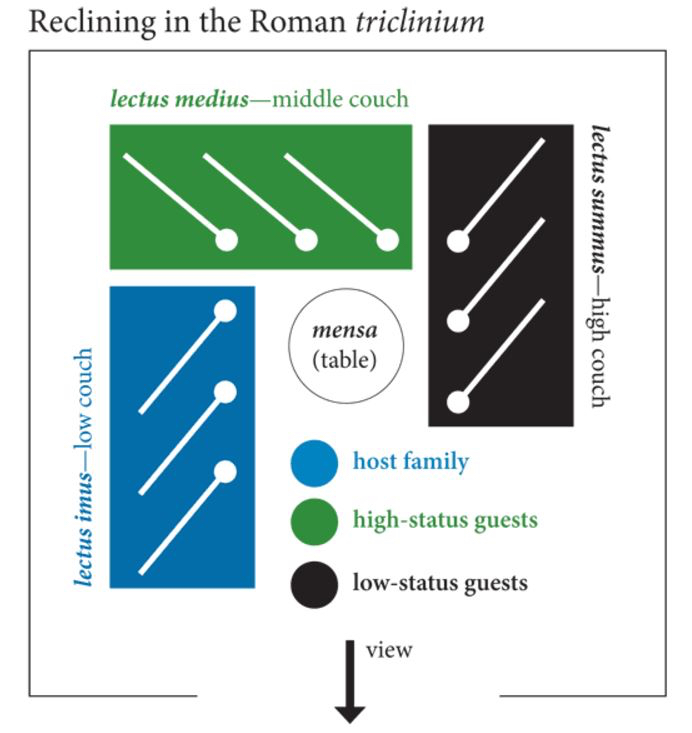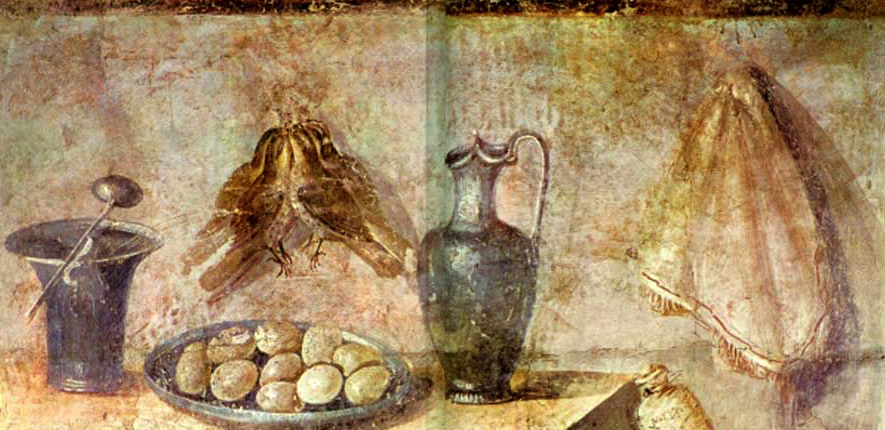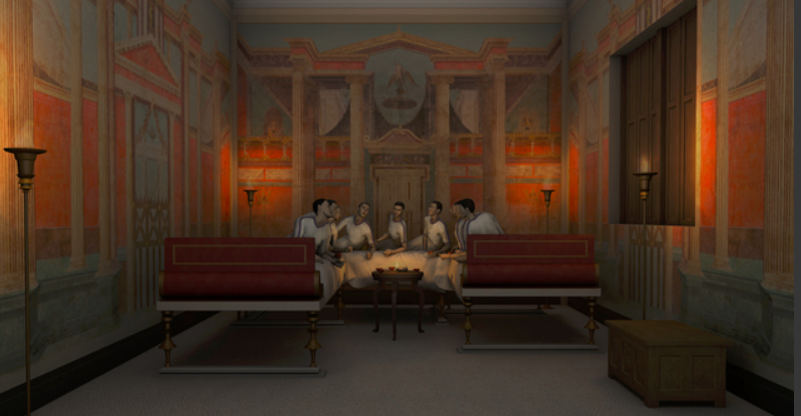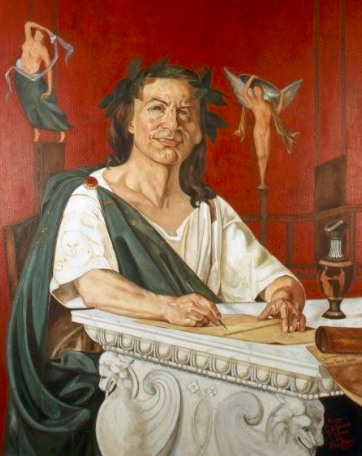Welcome back, Romanophiles!
In part one of this two-part series on food and dining in ancient Rome, we looked at the various foods that would have appeared on the tables of average Romans and how this varied depending on economic status or geographical region. If you missed that post CLICK HERE to read it.
This week, in part two, we’re going to take a brief look at the eating habits and formalities of dining in ancient Rome.
When it comes to eating, we seem to have inherited some of our modern-day habits from the Romans.
They normally ate one large, main meal a day, along with two smaller ones. However, the ientaculum, that is, breakfast, to the Romans, was not the most important meal of the day as we are sometimes told. In fact, Romans might have skipped this altogether before heading down to the Forum or visiting with clients or benefactors.
Breakfast in ancient Rome was light, and most likely involved puls, a sort of porridge, or some bread, perhaps dipped in honey or olive oil. They didn’t attack the day with a lumberjack breakfast in their stomachs!
In the early days, the midday meal or lunch, known as the cena, was the main, large meal of the day. This would perhaps have coincided with the sexta, the sixth hour of daylight or siesta time of day. For more about the Roman siesta, CLICK HERE.
Lastly, the Romans would have enjoyed a lighter evening meal called the vesperna, perhaps involving bread and cheese, or some fruit.
Sensible eating for those early Romans!
Over time, however, the midday lunch became a lighter meal known as the prandium, and the cena, the main meal, was moved to the evening.
For the poor, most meals would have consisted of puls or bread, sometimes with some sort of meat, or vegetables if they were available. There was certainly less variety among the different meals of the day if one was not wealthy or at least well-off.
For the rich and well-to-do, things were different. As the cena was the large meal of the day it would have included three courses of food.
The first course was the gustatio or promulsis, and this would have involved appetizers of olives, eggs, raw vegetables, and simple fish or shell fish.
The second, or main course, the prima mensa, often included cooked vegetables and meats, the types and amounts varying greatly, depending on the occasion and wealth of the family or individual.
And lastly came the sweet course, the secunda mensa. This is when fruit and sweet pastries would have been served.
But what about the etiquette of dining? What was the etiquette? How did they sit? Did the Romans just move from course to course, gobbling up all that was placed before them?
Not exactly. In fact, there was a rigid system of seating, or placement. Contrary to modern views, most Romans ate while sitting, but when it came to the wealthy, they tended to recline on couches, especially at dinner parties.
At a banquet, or convivium, there would also have been entertainment between courses, perhaps by clowns, dancers, or readings by poets.
Food was eaten with fingers, and cut with knives. Spoons were also used, but forks were not.
Today, when one attends a dinner, there are sometimes places assigned to guests. There might even be name cards, and some hosts might distance themselves from their least favourite guests at the table.
Well, this was also true in ancient Rome!
I want you to imagine you’re invited to an evening cenaat a senator’s home. You’re greeted in the atrium and led through the house to the dining room, the triclinium, just off of the peristyle garden. It’s dark out, and the scent of lemon blossoms and jasmine are on the night air. After a cup of watered wine, you’re shown into the triclinium by one of the well-dressed slaves who shows you to the couch known as the lectus medius, the middle couch of three, the couch of honour.
At this point, you’re very happy, for your host, seated with his wife on the lectus imus, the low couch, has honoured you above all other guests. The other guests behind you grin and bear it as they are shown to the high couch. From where you are, you have a wondrous view of the night garden and all of the other guests, and conversation comes easily, for you do not have to twist and turn.
Sound like a good evening? It could be. But the Romans took seating of this sort very seriously.
Horace (65 B.C. – 8 B.C.), in Satire VIII presents us with a scene depicting the seating arrangements and the trials of being a host in ancient Rome:
‘I was there at the head, and next to me Viscus
From Thurii, and below him Varius if I
Remember correctly: then Servilius Balatro
And Vibidius, Maecenas’ shadows, whom he brought
With him. Above our host was Nomentanus, below
Porcius, that jester, gulping whole cakes at a time:
Nomentanus was by to point out with his finger
Anything that escaped our attention: since the rest
Of the crew, that’s us I mean, were eating oysters,
Fish and fowl, hiding far different flavours than usual:
Soon obvious for instance when he offered me
Fillets of plaice and turbot cooked in ways new to me.
Then he taught me that sweet apples were red when picked
By the light of a waning moon. What difference that makes
You’d be better asking him. Then Vibidius said
To Balatro: “We’ll die unavenged if we don’t drink him
Bankrupt”, and called for larger glasses. Then the host’s face
Went white, fearing nothing so much as hard drinkers,
Who abuse each other too freely, while fiery wines
Dull the palate’s sensitivity. Vibidius
And Balatro were tipping whole jugs full of wine
Into goblets from Allifae, the rest followed suit,
Only the guests on the lowest couch sparing the drink.’
Seems like Horace had a lot of fun with this, and his satires are certainly good for a laugh! I do feel for that host.
But what was all this ‘status seating’ about?
In a relatively well-off Roman household, three couches in a triclinium were standard. These were arranged around a low table, or mensa, and these couches had specific names and purposes.
The lectus medius, the middle couch, was the couch of honour, and was where important guests were placed. Because of its position, guests seated here were able to talk easily with other guests and had the best view, whether onto a peristyle garden or some sort of rural landscape.
The lectus imus, the low couch, was reserved for the hosts. It allowed them to speak with the high status guests on the lectus medius, and also the guests sitting directly across on the lectus summus.
Last and least, the lectus summus, or the high couch. This was not like the high table at a wedding today. No. The lectus summus in ancient Rome was the opposite. It was reserved for the lower status guests, maybe even for children if they were permitted to attend. This couch possessed less of a view, though still allowed its occupants the chance to participate in the conversation, though they might have had to turn awkwardly to do so. If you were shown to the lectus summus, then it seems you knew your place at the gathering.
If it was a rather large banquet, we can assume that the farther from the hosts and guest of honour you were on lectus summus side of the triclinium, the less important you were considered, or at least less influential.

Plan of typical Roman couch placement in a triclinium (from Reclining and Dining (and Drinking) in Ancient Rome by Shelby Brown; The Iris – Behind the Scenes at the Getty)







